HTPC Flashback – A Decade in Review
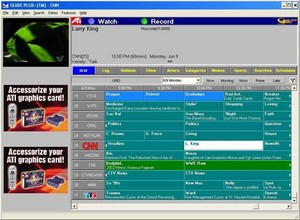
For those of you that are familiar with my writings, I often have a case of nostalgia. Having been involved in Home Theater PC’s for over 10 years now, I often reminisce at how this all started and where we are today. I think it was Alan’s blog about Start Menu’s that made me think about the plethora of Home Theater PC Software that has existed over the years, and just how much they’ve changed–and just how similar some of them are. I hope you enjoy this look back as much as I enjoyed trying to remember them! (Of course, if you remember anything I forgot, let us know in the forums!)
Here’s the list, in no particular order…
ATI All-In-Wonder Software
|
I have the fondest memories of this piece of software. It was bundled with ATI All-in-Wonder Radeon graphics cards, which were REVOLUTIONARY for having the cost savings idea of Graphics AND TV Tuner all-in-ONE! And it even came with a great remote with a touchpad. Keep in mind, this was before any other Media Center taught us how this (left) is NOT a 10 Foot Interface. But it sure was fun trying to teach my non-geek friends how to schedule a recording they could barely read on my old 32" Toshiba tube television’s whopping 640×480 display. |
Showshifter
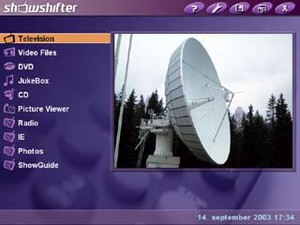 |
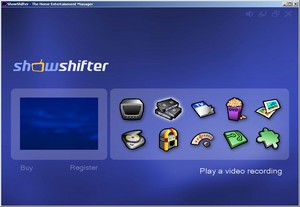
|
Started back in 2002, Showshifter was one of the oldest Home Theater PC
applications, which sadly bit the dust a couple years ago. Their
design/interface didn’t change much throughout the years, but it was one of the first and
was pretty popular.
SageTV
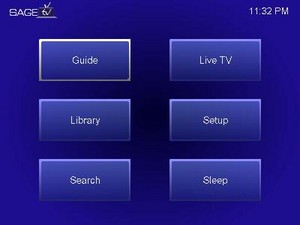
|
 |
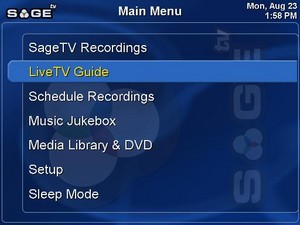 |
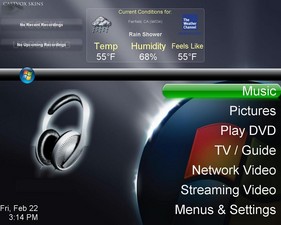 |
SageTV
is another one of the first HTPC companies that jumped onto the scene
in 2002. They prided themselves in customizability. In a world where
Windows Media Center and others were extremely rigid in their
integration, SageTV has, and still does rely on a phenomenal community
of users and developers who contribute to it and makes it people of
various tastes to enjoy it. Still a bit for the more technically
inclined, but arguably one of the best HTPC software on the market
today.
MyHTPC > Meedio
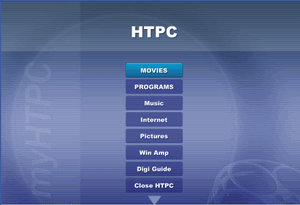
|
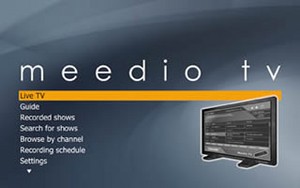 |
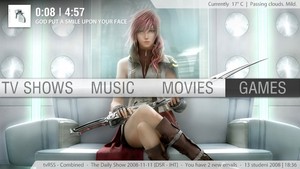 |
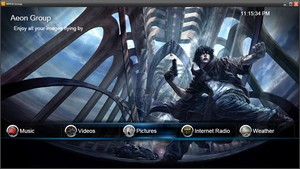 |
One of the most entertaining pieces of software for its time, MyHTPC
was a 100% customizable (and easy to do) front-end software. It was a
bit different than the others in that it was strictly a
front-end–meaning that it merely interacted between tasks and the
programs, instead of programs like SageTV which have their own
integrated players. It definitely made for some challenges, but it was
also the ultimate in flexibility as you could configure playback with
any software. Head on over to AVSForum and I’m sure you will find some
people who still are using a version of MyHTPC they took a long time to
perfect (ok, maybe just a few…but everyone remembers it!). Did I
mention that MyHTPC was completely FREEEE!! Along with a fantastic
community of support, it was definitely one of the most popular
applications in its day.
They leveraged their popularity and created an even slicker commercial
application in Meedio, which was quite short-lived. The most popular of
its features was their 3rd party applications store, called MAID. Even
to this day, no other software has come close to the seemless
integration of outside applications and plugins into a Media Center
application. Unfortunately, soon after creating an amazing amount of
buzz for their software and potential TV integration (something that
MyHTPC always lacked), Meedio was sold to Yahoo!….who took the
codebase and development community they had grown, and abandoned the
project entirely. Go figure.
Luckily for us, that community that made Meedio so popular did not
take death lying down, and created and continue to develop the aptly
named MeediOS
. Still a relative baby on the scene, MeediOS has impressed already
with some stunning visuals and the commitment of their dedicated
community. And oh yeah, it’s back to FREE!
Snapstream Personal Video Station > BeyondTV
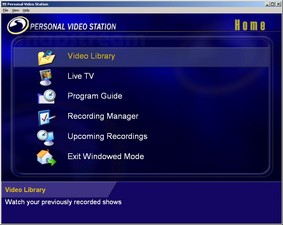
|
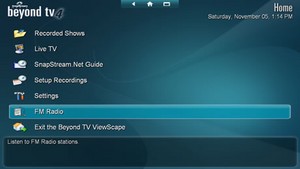
|
Snapstream
is another one of the classic HTPC companies which I’m happy to say
continue to thrive and innvoate in the market. They have not been
afraid to push the boundaries on their development, and have collected
some nice buzz recently on their search technology for businesses to
monitor keywords from TV channels. Personally, I was most impressed
with their Medusa setup. While many enthusiasts were hacking it with
whatever software, Snapstream was one of the first to really encourage
users to have a large multi-tuner setup.
Initially marketed as Personal Video Station, it got a facelift with
the BeyondTV moniker, and has since developed quite a brand with that
developing remotes, frontends and now even complete systems. While not
nearly as customizable as SageTV, it is a bit easier to setup with
comparable features, which has placed right near the top of the best in
class.
Windows Media Center (XP, 2005, Vista and Windows7)
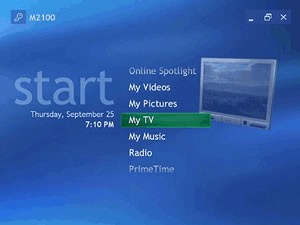
|
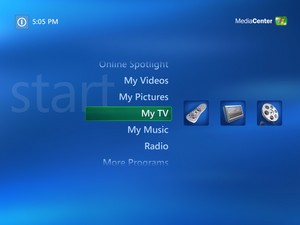
|
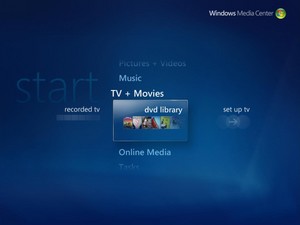 |
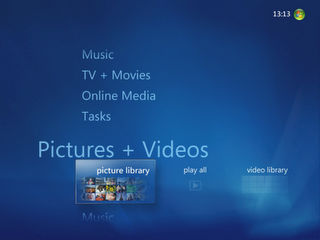 |
Love them or hate them, it’s hard to argue that the Home Theater PC
market would not be where it is today had it not been for Microsoft’s
2002 relase of their Windows Media Center platform. A bit different
than other 3rd party applications in that it was built into the
operating system and was originally exclusive to OEM PC vendors
(similar to how CableCard systems are today). With a fresh and modern
look to it, Media Center quickly gained ground and eventually became
the leader of the pack. Without any customizing or tweaking supported,
Microsoft gave us the first real out of the box and ready to go
experience, and all from the exclusive use of a groovy gray remote
control. Before this, most HTPC remotes included touchpads or other
mouse controls as it was still occasionally needed.
As time has progressed, so too has Microsoft’s vision blurred a little
on how they see Media Center in the home, but the fact that it is
already on a lot of computers makes it at least easy to try. They were
rarely the first to include features such as QAM support or multiple
tuners, but without them we would never have had cablecard (is that a
good thing?)…and they eventually do support those must have’s.
Media Portal
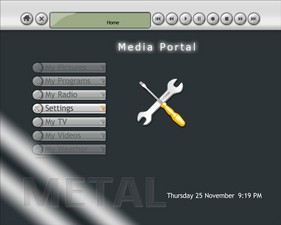
|
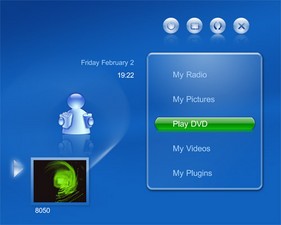 |
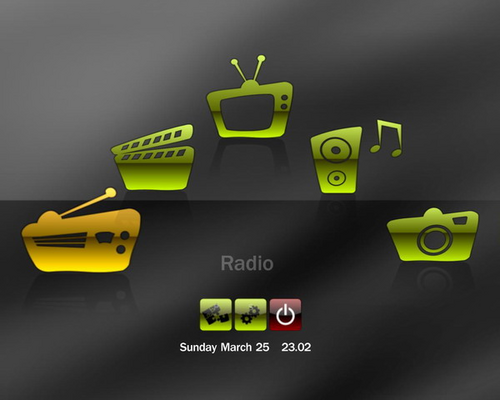 |
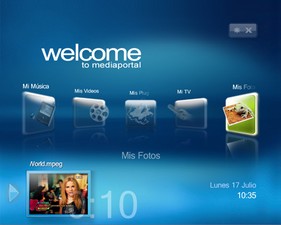 |
Media Portal
initially began as what appeared to be just another Windows Media
Center Clone with a basic interface, but as you can see from the
above…they’ve grown quite nicely! Entirely free, the Media Portal
community has a wealth of developers and just as important, DESIGNERS
who have helped make it one of the most attractive solutions on the
market. Similar to SageTV, Media Portal is highly customizable and
allows for many tweaks to configure and adjust. Setup is a bit more
technical than most however, but it’s hard to argue with their design
and supportive community.
ctPVR
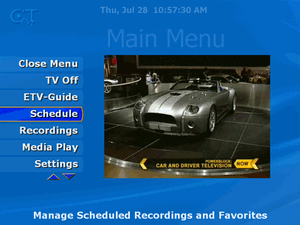 |
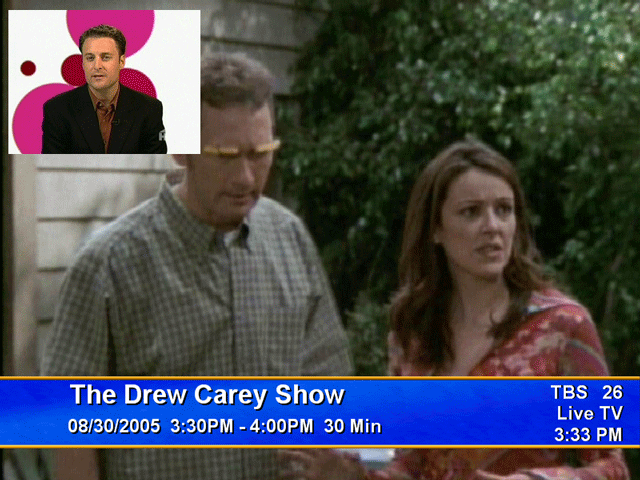
|
Oh CT-PVR, how were you able to include a feature which big
Microsoft still has been unable to deliver?!? That feature of course,
is Picture-in-Picture! CtPVR was always a bit behind from a user
interface standpoint, but they were the first (and only to-date) to
support PiP. The rather basic looking user interface always made me shy
away from them, but I had to credit their technological innovations.
ctPVR is no longer in development as they were sold to another company,
so who knows if we will hear from it again.
MythTV
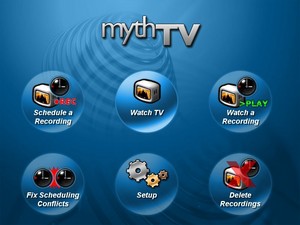
|
MythTV
It’s been so popular, that people have developed various versions based |
FREEVO
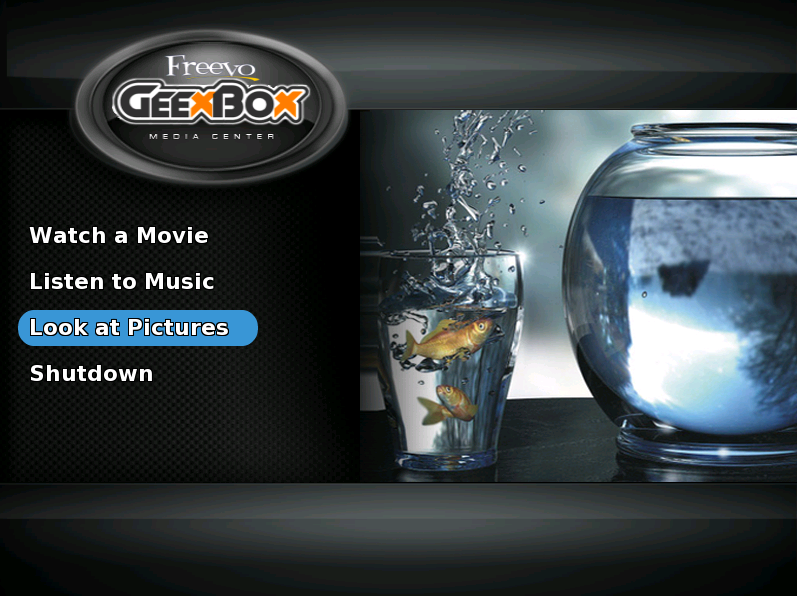
|
Freevo is along the same path as MythTV. Not much to say about it other than it’s out there, and it is pretty popular as well. The design is a bit different than MythTV, and it’s based on GeekBox. |
LinuxMCE
| Announced in 2007, LinuxMCE is another Linux HTPC software that is based partially off of the MythTV code (which is OK in the Linux world). What set LinuxMCE out, was their creator’s ridiculous sales pitch videos which announced how ridiculously easy, stable & compatible it was, and how it just demolished Windows Media Center in every way, shape or form. Given that, I hope you enjoy the screenshot of the application as much as I did. Needless to say…LinuxMCE has not exactly gained fast adoption. |
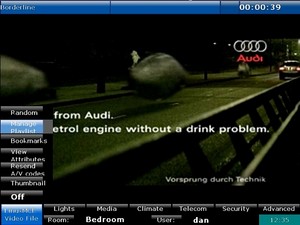
|
XLobby
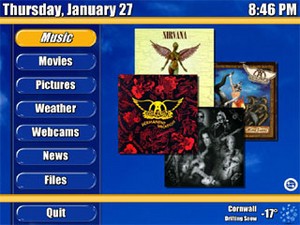
|
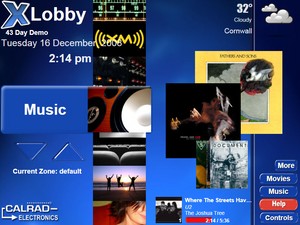
|
Xlobby
is a frontend HTPC solution for the professional dealer market. Don’t
tell that to the many loyal users from AVS-Forum however, who have been
loyal followers and supporters of the application for years! Founded on
the idea of being 100% customizable, it really has an appeal to
installers trying to not only satisfy many a customer wish, but also be
easy to use. It was never really meant to be for the mainstream, so the
difficulty of using is higher than most other apps, but as you can see
above, it really has grown in development as the HTPC world has grown.
XBMC
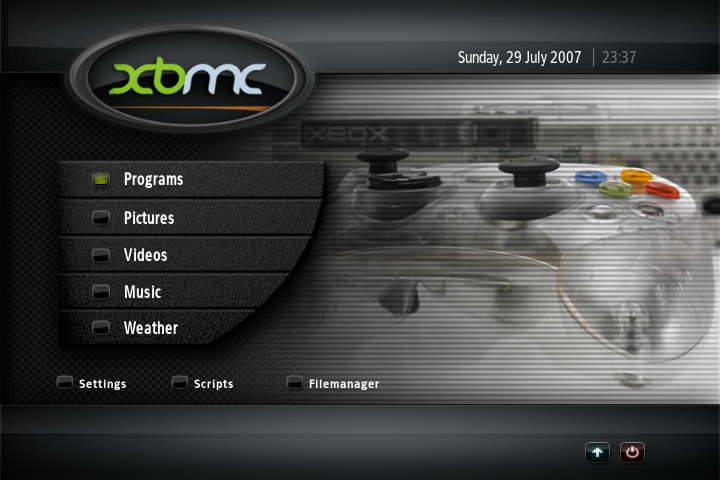
|
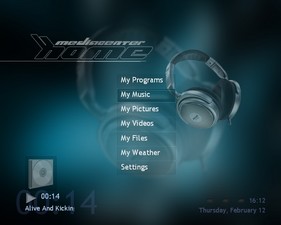
|
XBox Media Center (XBMC) has been so important on so many levels,
and it’s ironic that it’s original design was strictly for the old
black Xbox console. XBMC is actually the foundation on which the
aforementioned Media Portal was based on, as the group wanted to
migrate it to an actual PC, instead of a modified Xbox. Even to this
day, as the Xbox black console is old and obselete, plenty of people
keep them (or buy one) strictly to run as their Media Center solution.
And why not?! The interface was fantastic, stable and played a plethora
of file formats. It truly was revolutionary and we probably would not
have the XBox 360 or Playstation 3 Media interfaces we have today had
it not been for the popularity of XBMC.
TVedia
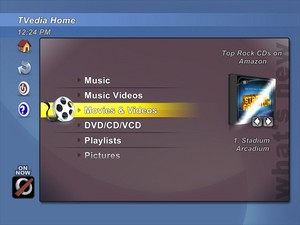
|
TVedia had been around for quite some time, but their softwawre never really took off like the others. It’s asking price was always reasonable, but to me it always seemed behind in terms of design and cutting edge features. TVedia has since shut down, but is just another case of a commercial application that could have used a design shot in the arm. |
Talisman
| Talisman is an application designed to modify your desktop’s appearance (think WindowBlinds to the extreme), and the reason I bring it up is because it shows the desparation us HTPC-fans were in during the growth stages, when there were simply no attractive HTPC interfaces around. So, with Talisman you could essentially design your own Front-end. Not extremely popular, but definitely shows the growth of the industry. |
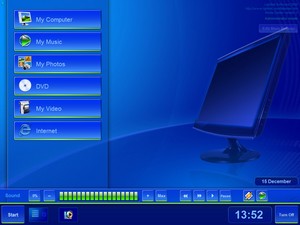 |
Intervideo/Nero/Cyberlink/Imedian
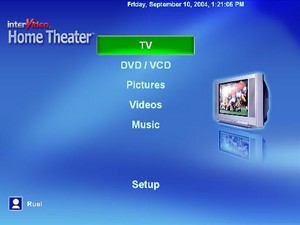
|
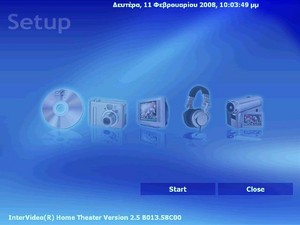
|
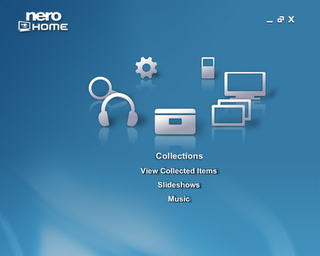 |
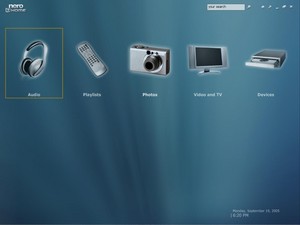 |
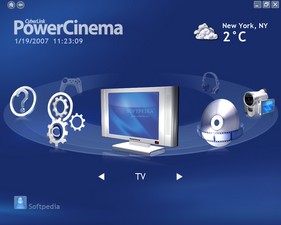 |
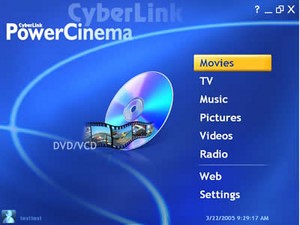 |
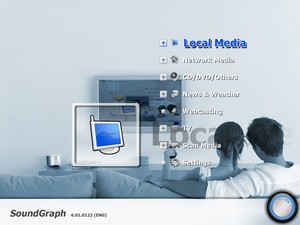 |
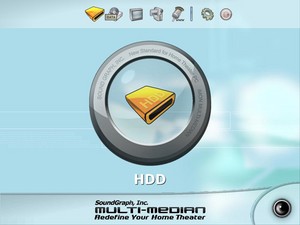 |
I am bundling together the HTPC software solutions from Intervideo,
Nero, Cyberlink and Imon/Imedian because they all show really ho these
have been fairly paltry attempts at a comparable solution for the user.
The majority of these are bundled as freebies along either a display
device, remote or other software, and you can see from the interface
that they really lack innovation or exciting design. Not to say these
wouldn’t be of any use, but just with so many free and superior
alternatives I certainly hope users are aware and go with a better
solution.
JRiver Media Center
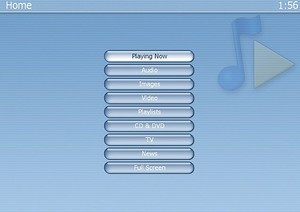
|
JRiver does large music collections really, really well. They are not however, on the most cutting edge when it comes to a 10′ Media center-type interface as shown. It’s really just a basic and simple interface that allows access to their more powerful software. If you have an obscene volume of music tracks, it may be worth checking out, otherwise, there’s better alternatives. |
Got All Media
| A smaller development, Got All Media is another in one of the earlier HTPC pieces of software which never really took off. They haven’t released anything since April of 2008, this commercial piece of software could use a facelift (or two!). |
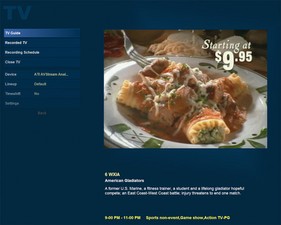
|
And that’s what 10 years in the home theater PC world has looked like,
literally. If you’re keeping track, that’s over 25 different programs
designed to essentially do the same thing. Of course, not all of these
programs are still in existance, but I think it goes to show the growth
of those that do, and also shows where we have been. In a market that
initially started fairly bland and simple, where playback of content
was the primary, we have since grown to expect more from our Media
Center software, not just being powerful and customizable, but also
attractive–also known as the WAF (Wife acceptance factor).
I don’t think that it’s by chance that SageTV, BeyondTV and Windows
Media Center have climbed to the top of food chain, with their
innovative design, reasonable prices and quality feature set. It’s even
more impressive their success given the immense competition from free
competitors such as MythTV, Media Portal and MeediOS, as they offer
phenomenal value for the quality of product they provide.
So where does this leave us? Where will we be 10 years from now?
Hopefully HTPC’s continue to grow in popularity. I think the one thing
lacking in the current solutions is interactivity and online
integration. I don’t think it’s by coincidence that a company like
Boxee can become so popular in such a short time, since it offers you a
10′ portal to a multitude of online content sites (such as Hulu). The
future is sure to be the hybrid of both and I’m sure will be as fun a
voyage as the last 10 years have been.
